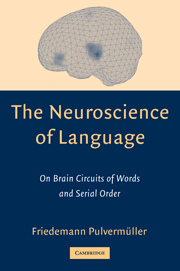Book contents
- Frontmatter
- Contents
- Preface
- The Neuroscience of Language
- 1 A Guide to the Book
- 2 Neuronal Structure and Function
- 3 From Classic Aphasia Research to Modern Neuroimaging
- 4 Words in the Brain
- Excursus E1 Explaining Neuropsychological Double Dissociations
- 5 Regulation, Overlap, and Web Tails
- 6 Neural Algorithms and Neural Networks
- 7 Basic Syntax
- 8 Synfire Chains as the Basis of Serial Order in the Brain
- 9 Sequence Detectors
- 10 Neuronal Grammar
- 11 Neuronal Grammar and Algorithms
- Excursus E2 Basic Bits of Neuronal Grammar
- Excursus E3 A Web Response to a Sentence
- 12 Refining Neuronal Grammar
- Excursus E4 Multiple Reverberation for Resolving Lexical Ambiguity
- Excursus E5 Multiple Reverberations and Multiple Center Embeddings
- 13 Neurophysiology of Syntax
- 14 Linguistics and the Brain
- References
- Abbreviations
- Author Index
- Subject Index
Excursus E3 - A Web Response to a Sentence
Published online by Cambridge University Press: 15 December 2009
- Frontmatter
- Contents
- Preface
- The Neuroscience of Language
- 1 A Guide to the Book
- 2 Neuronal Structure and Function
- 3 From Classic Aphasia Research to Modern Neuroimaging
- 4 Words in the Brain
- Excursus E1 Explaining Neuropsychological Double Dissociations
- 5 Regulation, Overlap, and Web Tails
- 6 Neural Algorithms and Neural Networks
- 7 Basic Syntax
- 8 Synfire Chains as the Basis of Serial Order in the Brain
- 9 Sequence Detectors
- 10 Neuronal Grammar
- 11 Neuronal Grammar and Algorithms
- Excursus E2 Basic Bits of Neuronal Grammar
- Excursus E3 A Web Response to a Sentence
- 12 Refining Neuronal Grammar
- Excursus E4 Multiple Reverberation for Resolving Lexical Ambiguity
- Excursus E5 Multiple Reverberations and Multiple Center Embeddings
- 13 Neurophysiology of Syntax
- 14 Linguistics and the Brain
- References
- Abbreviations
- Author Index
- Subject Index
Summary
Simulationing sentence processing in grammar circuits is important because it shows the processes that postulated by a neuronal grammar to occur in the brain when congruent and incongruent word and morpheme strings are processed. The examples discussed in Chapter 10 and Excursus E2 were introduced to illustrate the working of the envisaged grammar machinery, the principles of which are less obvious from a more complex simulation. However, the earlier examples can be considered to be toy simulations because the strings under processing exhibit far less complexity than most sentences commonly used in everyday language.
It is therefore relevant to look at more complex examples of neuronal circuits that may be the basis of syntactic knowledge and syntactic processing. In this Excursus, a sentence discussed earlier in the context of conventional grammar models (see Chapter 7) is again the target. First, the algorithmic version of a neuronal grammar processing this and similar sentences is presented and the corresponding network described. Subsequently, activity dynamics caused in the grammar circuit by the sentence in the input are discussed. An animation of this simulation is available on the Internet at the books accompanying web page (http://www.cambridge.org).
We look first at sentence (1).
(1) Betty switches the machine on.
Putative syntactic structures possibly underlying the processing of sentence (1) are spelled out in the context of dependency and rewriting grammars (Section 7.5; Fig. 7.1). Also, a very tentative neurobiological circuit was proposed earlier that may underlie the processing of (1).
- Type
- Chapter
- Information
- The Neuroscience of LanguageOn Brain Circuits of Words and Serial Order, pp. 224 - 234Publisher: Cambridge University PressPrint publication year: 2003



